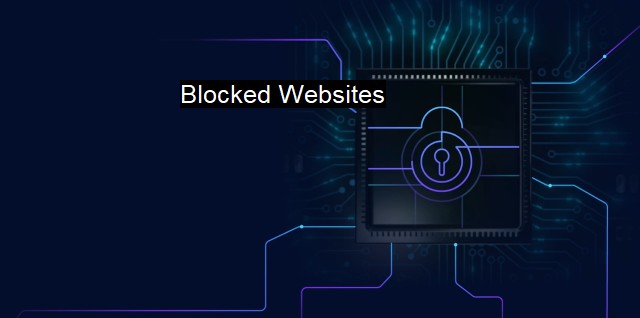What are Blocked Websites?
Unraveling the Mystery of Blocked Websites: Exploring Cybersecurity, Antivirus Software, and Access Techniques for Safe Browsing
Blocked websites are webpages that are not accessible through your internet connection due to various reasons. The process of blocking websites mainly forms a part of Internet censorship and it emerges as one of the key measures to proactively negate possible internet-borne threats.When a website is blocked, it means that you can't access its content because your internet service provider (ISP), governmental organization, or even your own network administrator has restricted access. This can be related to issues of confidentiality, network security, and content regulation.
Blocked websites are a common phenomenon in cybersecurity - a field focused on protecting all forms of digital data from threats, damage, or unauthorized access. This includes security against harmful system invasions such as malware, phishing, Trojans, spamming, and denial of service (DoS) attacks.
On this foundation, software solutions, including antiviruses and firewalls commonly deploy website restriction measures as one of their key protective elements. Antiviruses and firewalls function on incident prevention. This involves scanning the digital environment and detecting threats including suspicious or unauthorized actions. One familiar tactic is blocking websites known to be virulent or potentially harmful. By disallowing access to these locations, a large chunk of digital threats can be avoided.
Web addresses can be encrypted or fully blocked by the antivirus. Even trusted sites that are showing signs of potentially malicious activities can be blocked on a temporary basis until their status can be confirmed. More often than not, blocked sites contain security threats such as phishing, spyware, viruses, as well as inappropriate or even illegal content.
Traditional antiviruses based website blocking on identifying a unique signature of a known threat. In contrast, contemporary cybersecurity solution providers develop sophisticated tools and algorithms to proactively discern harmful or exploitative digital entities progressively rather than depending on pre-existing signature databases solely. These modern solutions rely on a systematic approach: real-time scanning of every activity episode, provide regular updates to the threat database, and the power to block websites on a case-to-case basis.
One of the methods used in blocking certain websites is through Domain Name Server (DNS) filtering. DNS transforms the numerical Internet Protocol (IP) addresses, which computers understand into domains which are easier for humans to comprehend. During DNS filtering, once a match to the 'no-access' list is encountered, the website will be blocked and an error message generated.
To effectively block malicious websites, organizations should cultivate an atmosphere of cybersecurity awareness and constantly update devices, software, and security systems. Invalid or expired certificates, lack of encryption through ‘HTTPS', pop-ups, and suspicious links are certain aspects that require attention and call for site blocking.
Though website blocking could be viewed as infringement of net neutrality or as a curb on free access to information, when placed under the larger canopy of cybersecurity matter, it often comes as a boon. By limiting access to harmful content both on purpose and unintentionally, cybersecurity systems can potentially prevent data breaches, loss of sensitive information, disruption of services and safeguard the integrity of the entire network and date it houses.
"blocked websites" form a critical aspect of maintaining cybersecurity and the healthy functioning of a digital ecosystem. Through the effective blocking of websites that hold a nefarious nature, counterproductive content, or threat to the system, both antiviruses and broader cybersecurity systems are able to provide a safer experience for all users of the digital realm.

Blocked Websites FAQs
What are blocked websites?
Blocked websites are web pages that cannot be accessed by a user due to various reasons. These websites are blocked by network administrators, internet service providers, or government authorities for several reasons such as security concerns or inappropriate content.Why do some websites get blocked?
Websites may get blocked due to security concerns, inappropriate content, copyright infringement, or even political reasons. Administrators block access to such sites to prevent users from accessing harmful content, protect their networks from cyber attacks, or comply with local laws and regulations.What are the risks of accessing blocked websites?
Accessing blocked websites can pose several risks such as exposing your device to malware, viruses, phishing attempts, or even identity theft. Additionally, accessing prohibited content can lead to legal repercussions, and your internet service provider may monitor and record your activity.How can I unblock a website?
You can unblock a website by using a virtual private network (VPN), proxy servers, or Tor browser. VPNs and proxy servers redirect your internet traffic through a different IP address, making it appear as if you are in a different location. This allows you to bypass geo-restrictions and access blocked websites. On the other hand, Tor browser uses a network of volunteers to direct your internet traffic through a series of virtual tunnels, making it impossible for third parties to track your activity.| | A | | | B | | | C | | | D | | | E | | | F | | | G | | | H | | | I | | | J | | | K | | | L | | | M | |
| | N | | | O | | | P | | | Q | | | R | | | S | | | T | | | U | | | V | | | W | | | X | | | Y | | | Z | |
| | 1 | | | 2 | | | 3 | | | 4 | | | 7 | | | 8 | | |||||||